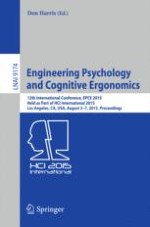
2015 | OriginalPaper | Buchkapitel
The Development of a Method to Assess the Effects of Traffic Situation and Time Pressure on Driver Information Preferences
verfasst von : Alexander Eriksson, Ignacio Solis Marcos, Katja Kircher, Daniel Västfjäll, Neville A Stanton
Erschienen in: Engineering Psychology and Cognitive Ergonomics
Aktivieren Sie unsere intelligente Suche, um passende Fachinhalte oder Patente zu finden.
Wählen Sie Textabschnitte aus um mit Künstlicher Intelligenz passenden Patente zu finden. powered by
Markieren Sie Textabschnitte, um KI-gestützt weitere passende Inhalte zu finden. powered by